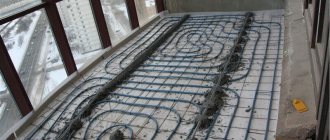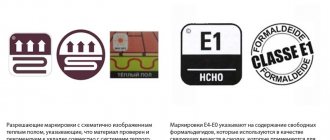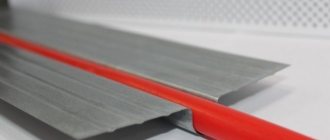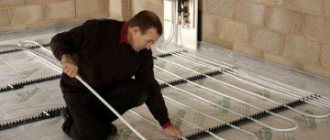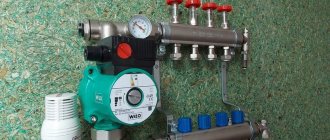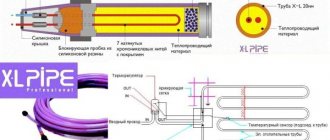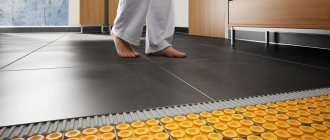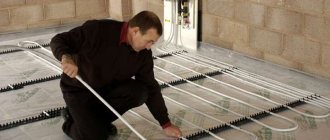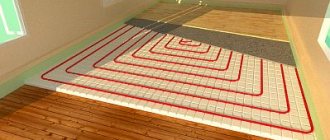Underfloor heating system: does it warm or create comfort?
First of all, we remind you that “warm floor” was originally created for comfort, and not as a separate heating element. Thus, even SNiPs indicate that the surface temperature of such a floor should not exceed 29°C. And for a water floor it should not exceed 50°C.
Thus, foreign flooring manufacturers also often warn that laminate flooring should not be heated above 85 degrees Fahrenheit. Translated, this is 29.44°C. But, the temperature of the warmest floor is not equal to the temperature of the laid laminate. And only those with a thickness of up to 7 mm are suitable for laminate. The thicker it is, the worse it will transmit heat.
And now - a little physics. From heated floors in a private house or apartment, only one thing is required: to provide more heat per square meter than the room loses over the same area. But the finishing ones have different thermal conductivity coefficients, and they influence the final result in their own way. Thus, ceramic tiles conduct heat much better than laminate or parquet, and carpet is the worst.
Video: how to choose flooring for heated floors
You need to be especially careful when choosing a floor covering for a water floor - its temperature is not so easy to regulate. For example, if you accidentally overheat an electric or infrared heated floor, it is not difficult to quickly cool it down by quickly turning it off, but the water in the pipes can remain hot for quite a long time. And during this time, the same parquet may have time to completely deteriorate from the inside.
But, if the floors in your home are so cold that even stepping on the carpet is unpleasant, then a heated floor system underneath is still advisable. Just before laying carpet on top, be sure to find out about its composition.
Thus, in order not to make a mistake, we suggest that you buy materials only in trusted places, for example, we recommend the Gipostroy online store - https://www.gipostroy.ru/catalog/category/napol-nye-pokrytiya, here you will be offered Wide range of flooring at good prices. Just keep in mind that any underfloor heating system is first accurately calculated, and only then installed. And the thermal conductivity of the finishing floor material is taken into account first of all.
An interesting point: the more glue there is in the material, the less the temperature has its negative effect.
Electric heated floor - film or cable?
Let us immediately note that the most economical option for electric transformer substations does not exist - any heating systems consume energy equally (under equal conditions). When choosing, we take into account other criteria: cost, type of coverage, purpose of the room, and so on. Our recommendations:
- The best heated floor for tiles is cable mats; in second place is a heating cable in a screed. The mats come with a thinner heating conductor; tiles are immediately laid on top of a thin layer of construction adhesive 2...3 cm. Thermal film should not be used.
- When installing an electric floor during construction or major repairs, definitely choose a cable, preferably a self-regulating one. The option is suitable for all types of coatings and premises, including bathrooms, toilets, kitchens.
- If you do not want to break the existing screed, take a heating polymer film and lay it under the linoleum or laminate. Select heat output according to the type of flooring (from 130 to 230 W/m²).
- In rooms with high humidity - bathrooms, toilets - film TP is not recommended. Contacts in the floor are protected by bitumen linings, which over time may lose their insulating ability, and electric shock is possible.
Installation of thermal film - the photo shows bitumen pads that cover the electrical terminals on both sides - Film heated floors are appropriate in any dry rooms with low thresholds that do not allow creating a full-fledged “pie” - insulation + cement screed.
- If you plan to use the TP as the main heating, definitely pour a concrete monolith with a cable. A film with high heat transfer will heat up to a high temperature, which may damage the coating.
Reference. The diameter of the heating conductor is comparable using the example of products from the well-known company Devi. The size of the resistive cable for the screed is about Ø5 mm, the wires on the mat are up to 3.5 mm.
Regarding heating cables, the question often arises as to which one is better to use: single-core or two-core. We answer: there is not much difference in terms of efficiency and cost. The difference lies in the connection method: a single-core section is connected to the electrical network at 2 ends, a two-core section is connected to one end (a coupling is installed on the second).
Some types of cables can be laid not only under tiles, but also mounted “dry” under parquet boards, laminate and other flooring materials.
Laminate: is it always safe?
But here a paradox arises: most laminate manufacturers indicate on their products that they cannot be used with heated floors, but film manufacturers not only allow it, but also recommend it. But the laminate, specially designed for such a system, has high thermal conductivity. Those. This is a laminate with a special symbol.
It's all about the material. Thus, it is impossible to lay a laminate on a heated film floor, which has a more porous structure, and the moisture-repellent or binder impregnation is not resistant to constant heating and cooling cycles. If you put such a laminate, it will soon crack and begin to come apart at the seams.
You can also lay laminate flooring on a water-heated floor. It is only important to purchase a special substrate for this; the laminate itself needs to be at least class 32, and adjust the heating to 30°C. After installation, turn on the system, and install the transition strips only after two weeks. Just take a photo of the fixed underfloor heating pipes before pouring the screed, otherwise it will be difficult for the carpenter to figure out where to drill later.
Although usually under the laminate they do not make a water-heated floor, but under a film one. Moreover, the infrared floor itself must be placed directly on the substrate - and not under it. Like this:
And now - about the danger. This is what’s bad about the myth that you can buy the simplest and cheapest laminate and lay it on a heated floor system: in this case, no one is now safe from poisoning. Any laminate, even in a cold state, releases a small amount of formaldehyde from the MDF board - within the permitted limit. But when heated above 26°C, this process goes two or three times faster. And in a poorly ventilated room with such a floor, a person can feel the real symptoms of poisoning: headache, nausea and inflammation of the respiratory tract. That’s why it’s important to carefully select your flooring – you don’t want a “silent killer” in your own home, do you? After all, no manufacturer will be held responsible for the fact that you used its product for other purposes. There wasn't a stamp on the laminate that allowed it to be laid on a heated floor? This means that it was impossible to put it down.
How to properly install a thermostat for a heated floor and other questions
Warm floors have long been nothing new in a modern home, but for the average user, this equipment still raises a lot of questions about installation, maintenance and repair. One of the main elements of an electric heating system is a thermostat, which works in conjunction with a temperature sensor. The sensor takes readings about environmental changes and transmits them to the regulator, which in turn makes adjustments to the operation of the heated floor. It is these two elements of the heating supply system in the house that we will try to consider from the point of view of the average user.
Where to install the thermostat when installing a heated floor?
When choosing a location to install the thermostat, you must be guided by the following considerations. The thermostat must be installed on the wall in a convenient and accessible place. It is also important to take into account the fact that when arranging furniture, you can block access to the device with a large sofa, wardrobe or other piece of furniture. It is unacceptable.
The temperature sensor is located in the screed inside the corrugated pipe. Uncured cement or tile adhesive must not come into contact with the sensor. If necessary, the user or repairman must be able to replace equipment that has failed the temperature sensor.
A thermostat designed to regulate the operation of a heated floor in rooms with high humidity (sauna, bathhouse, swimming pool, bathroom) must be located outside the room.
The diagram below provides basic recommendations and dimensions for installing a thermostat and sensor.
Why doesn't the floor heating thermostat turn on?
A popular question from the “why” series is the underfloor heating thermostat does not turn on/does not work. To find out the reasons for such an incident, it is necessary to check whether power is supplied to the regulator terminals. To do this, after first turning off the circuit breakers in the distribution panel, remove the thermostat filling from the mounting box. Turn on the power supply again and use a tester to check the presence of voltage at the supply terminals. If there is no voltage, then the fault should be looked for in the electrical wiring, and not in the underfloor heating system. If during the test it turned out that the phase cable is connected to the zero terminal of the regulator, then it is necessary to perform a phase change, i.e. just swap the wires. If there is power, the wires are correctly phased, but the thermostat display does not light up, then the device itself has failed. To restore system operation, the thermostat should be replaced.
Why doesn't the floor heating thermostat turn off?
Another common problem in the operation of heated floors is that the thermostat does not turn off and, accordingly, the system operates around the clock. In this case, the thermostat does not turn off because it does not reach the specified heating mode. Most likely, the thermostat itself is faulty; to be sure that it is broken, set the maximum heating temperature. If in this case the device does not turn off, it means that it is definitely faulty and requires replacement.
Why does the heated floor heat up with the regulator turned off?
In fact, there may be several reasons for this behavior of the heating system.
The first reason is the inertia of the heated floor. It does not cool down instantly, it takes some time, about 1 hour, so it seems that after turning off the heated floors continue to heat.
The second reason is that the heating system is somehow connected directly, bypassing the thermostat. In this situation, it is necessary to put the electrical wiring in order and everything will work as it should.
Why does the floor heating thermostat click?
Clicking of the thermostat is a sign that the heated floor is on/off. If the thermostat “clicks” frequently, it means that when installing the heating you installed the temperature sensor too close to the heating elements. The floor does not have time to heat up, and the sensor already reacts to temperature changes. The sensor mounting point needs to be changed. Loud clicks of the thermostat are typical for a situation where the conductive contacts are loosely tightened in the corresponding terminals.
See also
Share on social networks:
Thermostats are widely used in both underfloor heating control systems, air conditioning and ventilation control systems, as well as in anti-icing and snow-melting systems. Regulators are used in underfloor heating systems both for comfortable (additional) floor heating in rooms with other heating sources, and for main heating, when the underfloor heating is used as the main and only source of heating.
Overview of thermostats
Maintaining a constant floor temperature
Easy programming of floor temperature
For open wiring
In this article we will talk about regulators that are used to heat underfloor heating. Comparison of thermostats for anti-icing and snow-melting systems in another article.
Wood
Thus, natural wooden floors can be heated from systems only up to 27°C. Higher temperatures will dry out any tree. Just adjust the heating system in advance so that the level does not exceed 2/3 of the total power. In any case, you cannot turn on the heating immediately after installation - only gradually, over several days.
Also be careful when choosing fiberboard as a substrate (for example, under PVC film). For example, in Russia they produce such a type as soft fiberboard. It is environmentally friendly, has a high specific capacity (2.3 kJ/kg*K) and low thermal conductivity (0.042 W/m*K). This is a wonderful substrate for cold concrete and a completely unsuitable layer between the heated floor system and the floor covering.
Parquet and engineered boards
A modern engineered board can be used for a heated floor system, but the floor itself cannot heat up much. But such practice also exists in construction. Take one that is no thicker than 16 mm and no more than 150 mm wide. This way it will warm up much better. You can also use engineered parquet. Price – within 2500-3000 rubles.
Parquet board is also a suitable option, but it must be laid exclusively in a floating way:
When choosing a parquet board for these purposes, give preference to one that is coated with oil rather than varnish. Suitable for underfloor heating and adhesive plug, 4 mm thick.
Ceramic tiles: dispelling the myths
The most suitable flooring of all existing ones is ceramic tiles. It is almost 100% environmentally friendly and easily tolerates numerous heating-cold cycles.
But tiles and porcelain stoneware also have some disadvantages. The fact is that too noticeable heat is not at all as beneficial for the feet as manufacturers sometimes want to present. Yes, for those who often get cold and get a cold from just touching the cold with their feet, this is the way out. But it is not at all necessary to install it in the nursery. After all, the younger generation is active, playful and feels great at 18°C. But in greenhouse conditions, children get sick more often, they are irritated all the time and get tired quickly. Just do an experiment sometime.
If you are most satisfied with ceramic tiles as a covering for a warm floor, you can finish all the floors in the apartment with it. Just choose the right design: wood, stone or a specific design. And here is the installation process itself:
In addition, such a temperature has a beneficial effect on the proliferation of many types of bacteria, so the microclimate will soon also not be healthy. It is not for nothing that heated floors are completely prohibited in preschool institutions in Canada, and in France their use is limited. That’s why you don’t try to make the floor exactly warm, with a temperature of 30°C – it’s enough to make it comfortable, and a dense board will only contribute to this.
Fashionable unusual coatings: what are the advantages?
But ordinary tiles are also bad because in the summer they are still cool, and walking on them barefoot is unpleasant. The same cannot be said about modern PVC tiles - they are not expensive, look beautiful, and heat well even without underground pipes. And with a heated floor system it’s even better. And, at the same time, walking on such a surface in the summer is also pleasant.
Modern self-leveling floors are also good at raising heat from the system - they can even be made with fashionable 3D technology. The installation process is also quite simple:
Natural stone is also good and it actually appears today even in apartments.
Adjust the heated floor using the heating curve
A warm floor, of course, like any other heating element, consumes energy as soon as it starts working. Anyone who wants to save on consumption can significantly reduce their energy costs. To do this, you should pay attention to the rules of underfloor heating. A very important component is the setting of the so-called heating curve. This term forms the relationship between the energy supply temperature and the outside temperature. Here, the flow describes the temperature at which the water is heated on its way from the heat source to the underfloor heating. By the way, the flow temperature in heated floors is significantly lower compared to other radiators.
Modern heated floors work depending on the weather
Depending on the outside temperature, the supply temperature is adjusted using the actual heat demand. Of course, it is important not only how cold or mild it is outside, but also how individual heating looks. For example, do you need a slightly higher room temperature or are your space heating costs particularly high? If the heating curve has to be set manually, this means: when the outside air temperature drops, the flow must be set higher. Modern flooring models also make these adjustments automatically.
This is fundamentally important because based on the outside air temperature, the flow temperature must adapt in order to actually achieve the desired temperature as quickly and economically as possible. If the room temperature drops too quickly during the coldest winter days, the slope of the heating curve must be increased. This ensures that the desired temperature is achieved with the least loss.
In adjusting underfloor heating there is no single rule of thumb for the heating curve
The steeper the heating curve, the higher the flow temperature in degrees Celsius. There is no rule of thumb with the heating curve. Because the heat actually felt varies depending on different aspects. There are people who tend to tolerate cold worse than others. At the same time, activity also plays a role. Because those who move around the house more experience the cold less. Therefore, the heating curve should always be based on personal preference and circumstances if you want to customize your underfloor heating.

